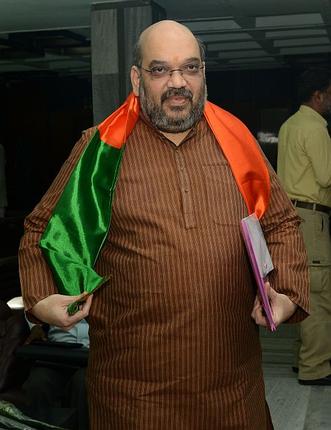 July 24;The BJP’s 2009 vote share in Gujarat could rise by seven percentage points were the general elections to be held now, even though Chief Minister Narendra Modi’s popularity has plunged five percentage points in his home state — 49 per cent to 44 per cent — since his government returned to power last December, and satisfaction with his administration slipped from 72 per cent to 64 per cent since July 2011.
July 24;The BJP’s 2009 vote share in Gujarat could rise by seven percentage points were the general elections to be held now, even though Chief Minister Narendra Modi’s popularity has plunged five percentage points in his home state — 49 per cent to 44 per cent — since his government returned to power last December, and satisfaction with his administration slipped from 72 per cent to 64 per cent since July 2011.
Even more curious, even as he has emerged in the public domain as the BJP’s prime ministerial candidate for 2014, two other chief ministers belonging to his party, find greater favour with the people of their own states. The level of satisfaction with Chief Minister Shivraj Singh Chauhan’s government in Madhya Pradesh is 82 per cent and with Chief Minister Raman Singh’s government in Chattisgarh is 75 per cent. Mr Modi’s government? Just 64 per cent. And in a table of 18 states, Gujarat is tied at 7th place with Maharashtra.
The approval ratings of the governments of Mr Chauhan (CM since November 2005) and Mr Singh (CM since 2003) stand at 64 per cent and 68 per cent – for Gujarat, the corresponding figure is just 44 per cent, placing Mr Modi ninth in a table of 18 chief ministers. Even more interesting, while the approval ratings of Mr Chauhan and Mr Singh have gone up since July 2011 (when the CSDS had done another survey) by 14 and four percentage points respectively, Mr Modi’s has plummeted in the seven months since he returned to power for a third time in end-2012.
Of those polled in Gujarat, 64 per cent feel Mr Modi’s government is corrupt; only a marginally higher 66 per cent believe the central government is corrupt. Paradoxically, satisfaction with the UPA government is the highest in Gujarat of the 18 states polled, while people’s perception about corruption in the state and at the Centre is almost similar – 64 per cent and 66 per cent.
These are some of the confounding findings of the CNN-IBN-The Hindu Election Tracker, conducted by the Centre for the Study of Developing Societies (CSDS).
Quite clearly, there is a problem with Mr Modi’s famed model of development and a looming gap between his governance – high levels of corruption, dissatisfaction with the administration — and Mr Modi’s perceived leadership qualities, a factor that apparently papers over the cracks.
These seemingly contradictory findings also explain why the Congress’s meticulously collated statistics about corruption, relatively poor social indicators and Mr Modi attributing high malnutrition rates in his state to young women being “beauty-conscious” were swept away by the BJP’s high-octane, glitzy, show-stopping campaign during last year’s assembly elections.
Or indeed, it could be that the lasting impact of the handling of the anti-Muslim riots of 2002 in Gujarat that has left people in the state with the lasting impression that what they need is a “strong” leader.
In 16th century Italy, Machiavelli, describing the ideal leader, had written in The Prince, “…whether it be better to be loved than feared or feared than loved? It may be answered that one should wish to be both, but, because it is difficult to unite them in one person, is much safer to be feared than loved, when, of the two, either must be dispensed with”. Of course, four centuries later, Gandhi updated that, saying, “I suppose leadership at one time meant muscles; but today it means getting along with people.”
If general elections are held now, the BJP’s 47 per cent 2009 vote share would climb to 56 per cent, the CSDS survey says; the Congress’s would fall from 43 per cent to 34 per cent. In 2009, the Congress, it may be recalled, had done extremely well, winning 11 Lok Sabha seats, even as the BJP bagged 15.
Interestingly, from 1995, the year the BJP came to power inGujarat, the party’s vote share in the assembly elections grew steadily. It peaked at 49.85 per cent months after the riots in 2002, in Mr Modi’s first election as chief minister. But since then, the BJP’s vote share has been gradually falling: in 2007, it was 49.12 per cent, in 2012, it was 47.9 per cent.
In the general elections, too, the BJP’s vote share in Gujarat has been slipping – from 52.48 per cent in 1999 (during Keshubhai Patel’s chief ministership) to 47.37 per cent in 2004, to 46.5 per cent in 2009.
However, if Mr Modi is seen as the BJP’s prime ministerial candidate, there could be a spike in the party’s vote share in the state, as the CSDS survey suggests. Indeed, while 41 per cent across 18 states feel the BJP should project Mr Modi as PM, the figure in Gujarat is higher, 49 per cent.
Another interesting nugget from the survey is that BJP general secretary Amit Shah, charge sheeted in the encounter cases of Sohrabuddin Sheikh and Tulsiram Prajapati, and now out on bail, is the people’s top choice for chief minister in Gujarat, were Mr Modi to move to Delhi. Anandiben Patel, preferred by traditional BJP and Congress supporters is the second choice.
Clearly, the Gujaratis, as a whole, if the CSDS poll is accurate, prefer the muscular to the namby-pamby and law-abiding.
